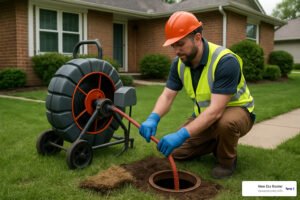Why Tree Root Removal Service is Essential for Your Property
Finding the right tree root removal service can save you thousands in property damage and costly repairs. Whether you’re dealing with cracked sidewalks, clogged sewer lines, or unsightly stumps, professional root removal protects your home and boosts curb appeal.
Quick Service Options:
- Stump Grinding – $101-$205 per stump, fastest method
- Complete Root Removal – $175-$516 average, most thorough
- Chemical Treatment – Slowest but least invasive to landscaping
- Emergency Services – 24/7 availability for storm damage
Tree roots can spread 20 feet deep or more, making them a serious threat to your property’s foundation, plumbing, and walkways. As one homeowner from Montreal finded: “We had 4 ash trees cut rapidly without grass damage and found the pricing amazing.”
Major risks of leaving roots untreated include:
- Foundation cracks and structural damage
- Sewer line blockages costing thousands to repair
- Tripping hazards for family and visitors
- Pest infestations in decaying wood
- Reduced property value
The average cost ranges from $175-$516 for professional removal, but this investment prevents much costlier repairs down the road. Professional services also handle permits, safety protocols, and proper disposal – removing the headaches from your plate.

Tree Root Removal Service Options & Best Practices
Choosing the right tree root removal service method can make the difference between a quick fix and a long-term solution. Each approach has its own personality – some are fast and efficient, others are thorough but time-consuming, and a few take the slow-and-steady route.

Manual removal is the old-school approach – roll up your sleeves and dig. Professional crews expose the entire root system by hand, then cut through roots with chainsaws and specialized tools. It’s like performing surgery on your yard. This method gets every last root, but it’s labor-intensive and can leave your landscaping looking like a construction zone. Expect to invest $175-$516 depending on how stubborn those roots decide to be.
Mechanical removal brings out the big guns – literally. Stump grinders turn stumps into wood chips faster than you can say “timber.” These powerful machines chew through stumps 2-4 inches below ground level in 30 minutes to a few hours. At $101-$205 per stump, it’s the speed demon of root removal. The catch? Some roots stay behind to potentially cause future mischief.
Chemical treatment takes the patient approach. Professional-grade herbicides like glyphosate get mixed 50/50 with water and applied to fresh stump cuts. Think of it as a very slow goodbye – it takes weeks or months, but your landscape stays pretty much untouched. The downside is dealing with regulations and protecting nearby plants from chemical drift.
Here’s the secret sauce: combining methods often works best. Many professional services start with mechanical grinding, then follow up with chemical treatment on stubborn roots. It’s like having your cake and eating it too – thorough results without breaking the bank or destroying your yard.
| Method | Cost Range | Time Required | Thoroughness | Landscape Impact |
|---|---|---|---|---|
| Manual | $175-$516 | 1-3 days | Complete | High disruption |
| Mechanical | $101-$205 | 30min-3hrs | Surface level | Moderate disruption |
| Chemical | $50-$150 | 2-6 months | Deep penetration | Minimal disruption |
When to Call a Tree Root Removal Service
Your property sends warning signals when roots are plotting trouble. Learning to read these signs can save you from expensive surprises down the road. We’ve seen too many Lake Elsinore homeowners wish they’d acted sooner when facing thousands in repair bills.
Sidewalk and driveway cracks are like nature’s graffiti – roots pushing up concrete slabs create trip hazards and potential lawsuits. Those innocent-looking cracks can quickly become major liability issues when someone takes a tumble.
Slow-draining sinks and toilets often signal root invasion in your sewer lines. Tree roots are sneaky – they find tiny cracks in pipes and expand inside like unwelcome houseguests who refuse to leave. What starts as minor slow drainage can escalate to complete blockages and sewage backups.
Foundation problems develop when large roots get too cozy with your home’s structure. Foundation settling and cracks compromise your entire house’s stability. We’ve witnessed homeowners face structural repairs that could have been prevented with timely root removal.
Pest infestations love decaying stumps and root systems. Carpenter ants, termites, and wood-boring beetles see rotting wood as prime real estate. These unwanted tenants often decide to expand their territory into your home’s wooden structures.
Storm damage creates urgent situations, especially during California’s unpredictable weather. When trees fall, their exposed root systems can destabilize soil and threaten underground utilities. Emergency tree root removal service becomes essential for safety and preventing further damage.
Tree roots can dive 20 feet deep or more – far beyond what weekend warriors can handle safely. Scientific research on tree-root hazards confirms that professional assessment prevents costly mistakes and dangerous situations.
Equipment & Safety Essentials for a Tree Root Removal Service
Professional root removal looks easy until you peek behind the curtain. The equipment and safety protocols involved go way beyond what most homeowners imagine. It’s like comparing a kitchen knife to a surgeon’s scalpel – both cut, but the precision and safety measures are worlds apart.

Stump grinders are the workhorses of root removal. Professional-grade machines cost more per day to rent ($100-$400) than many people spend on groceries, but they deliver results that consumer versions simply can’t match. These powerful beasts require skill and experience to operate safely.
Mini-excavators handle the heavy lifting when dealing with extensive root systems. They provide surgical precision when digging around underground utilities – something that’s impossible to achieve with hand tools. Chainsaws and specialized cutting tools in professional hands make quick work of thick roots while maintaining safety standards.
The most critical step happens before any digging begins. Professional crews always call utility companies to mark underground lines. We’ve seen DIY disasters when homeowners hit gas lines, electrical cables, or water mains. The resulting service outages, emergency repairs, and potential injuries make professional services worth every penny.
Personal protective equipment isn’t optional – it’s lifesaving. Safety goggles, hearing protection, cut-resistant gloves, and steel-toed boots protect against flying debris and equipment hazards. Hard hats and high-visibility clothing ensure crew safety, especially when working near traffic or overhead hazards.
Liability insurance provides peace of mind that DIY projects can’t offer. Reputable services carry $2,000,000+ in coverage, protecting property owners from potential damages. This insurance becomes crucial when working near structures, utilities, or neighboring properties.
At New Era Rooter, our certified professionals train continuously on safety protocols and equipment operation. This expertise prevents the injuries and property damage that commonly plague DIY attempts. When you’re dealing with powerful machinery and underground utilities, experience makes all the difference.
Can You Remove Roots Without Removing the Tree?
Sometimes the tree isn’t the villain – just its wandering roots. Many property owners love their mature trees but hate where the roots have decided to explore. The good news is that skilled arborists can often solve root problems while keeping your beloved tree healthy and happy.
Root pruning is like giving your tree a strategic haircut. Professional arborists identify which roots to remove while maintaining the tree’s stability and health. The golden rule is never removing more than one-third of the root system and keeping cuts at least three times the trunk diameter away from the base. It’s a delicate balance between solving problems and preserving tree health.
Root barriers act like underground fences, redirecting future root growth away from problem areas. These 12-inch by 10-inch barriers guide roots around foundations, sewer lines, and walkways while allowing trees to flourish. Think of them as traffic directors for your tree’s root system.
Proper root management actually improves tree health by eliminating competing roots that fight for nutrients and water. Better soil aeration helps roots breathe easier, while improved drainage prevents root rot and disease. Reduced disease transmission between tangled root systems keeps trees healthier longer.
Success depends on the tree’s species, age, and overall health. Mature oak trees often handle root pruning like champs, while shallow-rooted species like maples need more careful consideration. Each situation requires professional assessment to determine the best approach.
More info about root trimming services – Our specialists evaluate each unique situation to find solutions that protect both your property and your trees. Sometimes you really can have the best of both worlds.
DIY vs Professional: Costs, Environmental Impact & Aftercare
Choosing between DIY and professional tree root removal service feels like a simple cost decision at first glance. But once you dig deeper (pun intended), the hidden expenses and risks often make professional services the smarter choice for your wallet and your peace of mind.

The sticker shock of professional quotes can tempt homeowners toward the DIY route. But here’s what that “cheaper” option really costs: tool rental runs $100-$400 daily for equipment that actually works, permit fees that many cities require, utility marking that’s legally mandatory, and disposal costs for all that debris. Don’t forget the potential nightmare of utility strikes or property damage that could cost thousands.
Meanwhile, professional services bundle all these expenses into one transparent quote. No surprises, no hidden fees, no frantic calls to the gas company because you hit something you shouldn’t have.
From an environmental perspective, the method you choose matters more than you might think. Stump grinding creates wood chips that naturally decompose and enrich your soil over time. It’s like giving your yard a slow-release vitamin boost. Complete removal disturbs more soil but eliminates any chance of regrowth.
Chemical treatments raise bigger environmental questions. Many herbicides that worked great for root removal are now banned because we’ve learned more about their impact on groundwater and surrounding plants. What seemed like an easy solution yesterday might not even be legal today.
DIY Root Removal: Tools, Techniques, and Hidden Risks
If you’re determined to tackle root removal yourself, let’s talk about doing it safely and effectively. The romantic notion of conquering that stubborn stump with your bare hands quickly fades when you’re three hours in and barely scratched the surface.
Your basic tool arsenal needs to include a quality spade and mattock for the initial digging, pruning shears and loppers for smaller roots, and either a chainsaw or handsaw for the big stuff. Don’t forget a pickaxe and grub hoe for breaking up that rock-hard soil that always seems harder than concrete.
The process itself follows a logical sequence. Call 811 first – this isn’t optional, it’s the law and your safety net. Water the area 24 hours before you start to soften the soil (your back will thank you). Dig systematically from the outside roots toward the center, cut progressively from small to large roots, then use leverage and patience to extract the root ball. Finally, backfill and compact the area properly.
But here’s where things get scary. The biggest risk isn’t the obvious stuff like chainsaw accidents (though those happen too). It’s hitting underground utilities that run closer to the surface than most people realize. We’ve seen homeowners turn a $200 stump removal into a $5,000 gas line repair nightmare.
Physical injuries pile up fast too – chainsaw kickback, back strain from lifting root balls that weigh more than your refrigerator, eye injuries from flying debris, and cuts from tools and sharp root fragments. Emergency room visits aren’t factored into most DIY cost calculations.
Rental equipment adds another layer of frustration. Consumer-grade stump grinders often lack the power for anything bigger than a sapling, leaving you with a half-ground stump and a full day’s rental fee. Scientific research on stump-removal methods shows that professional equipment significantly outperforms what you can rent at the local hardware store.
If you choose chemical methods, extreme caution is essential. Glyphosate mixed 50/50 with water applied to fresh cuts works, as does the rock salt method where you drill holes and fill them monthly. But these approaches take months to show results and may not be legal in your area. Always check local regulations before applying any chemicals.
Professional Services: Pricing, Permits & 24/7 Support
Professional tree root removal service delivers value that extends far beyond just getting rid of the stump. When you hire professionals, you’re buying expertise, equipment, insurance, and peace of mind all rolled into one package.

Pricing structure is straightforward and comprehensive. Small stumps under 12 inches run $101-$150, medium stumps between 12-24 inches cost $150-$300, and large stumps over 24 inches range from $300-$516 or more. Root system removal adds another $50-$200 depending on complexity, but you get exactly what you pay for.
What makes professional service worth it? Everything’s included: free on-site estimates with no surprises, permit applications handled by people who know the system, utility coordination through established professional relationships, complete cleanup so you don’t have to rent a truck, and site restoration that leaves your yard better than before.
Emergency response becomes crucial when nature doesn’t follow your schedule. At New Era Rooter, we provide 24/7 emergency service across Point Loma, San Diego, Lake Elsinore, Temecula, Chula Vista, National City, Escondido, Claremont, Spring Valley, Fallbrook, and Lemon Grove. Storm damage, root-related sewer backups, fallen trees blocking access, or unstable root systems after soil erosion don’t wait for Monday morning.
Certified expertise makes the biggest difference. Professional arborists bring years of training and ISA certification that ensures proper species identification, safe removal techniques, knowledge of local regulations, and insurance coverage that protects you from liability. When something goes wrong on a professional job, their insurance handles it. When something goes wrong on your DIY project, your homeowner’s insurance might not cover it.
More info about services – We believe in transparency, so we explain all your options and provide detailed estimates before any work begins.
Post-Removal Landscaping & Preventing Future Root Problems
Getting the stump out is only half the battle. Smart aftercare and prevention strategies ensure you won’t be dealing with the same problems again in five years.

Immediate site restoration requires attention to details most people overlook. Soil amendment with quality topsoil replaces what was removed, while avoiding compaction from heavy equipment protects the surrounding area. Drainage assessment ensures water flows away from structures, and pH testing catches soil chemistry changes that root removal sometimes causes.
Replanting strategy prevents future headaches. Choose species with less aggressive root systems, consider mature size and root spread, plant appropriate distances from structures and utilities, and select native species adapted to your local conditions. A little planning now saves major problems later.
Root barrier installation provides insurance for sensitive areas. Install barriers 18-24 inches deep using commercial-grade materials, ensure proper installation so roots can’t find a way around, and plan for regular inspection and maintenance. It’s like building a fence underground.
Mulch and wood chip reuse turns waste into garden gold. Fresh chips need 6-12 months composting before use around plants, but they work immediately for pathways and erosion control. Mix them into compost piles or use them to stabilize slopes and bare soil areas.
Ongoing monitoring catches small problems before they become big ones. Annual root checks, drainage monitoring, pest prevention by removing decaying organic matter, and utility line awareness all contribute to long-term success. Strategic landscaping with mature plant sizes in mind, regular maintenance of small root issues, professional consultation through annual arborist inspections, and documentation of all root work create a comprehensive prevention strategy.
Sewer line protection deserves special attention since root intrusion causes expensive damage. Regular video inspections every 3-5 years, preventive treatments with safe foaming herbicides for existing trees, and pipe upgrades with root-resistant materials during renovations all help protect your plumbing investment.
The money you invest in proper aftercare and prevention pays dividends by avoiding future root removal needs and protecting your property value. It’s the difference between solving a problem once and solving it over and over again.
Conclusion
When tree roots threaten your property, choosing the right tree root removal service makes all the difference between a quick fix and a lasting solution. We’ve seen too many homeowners try the DIY route only to end up calling professionals anyway – usually after hitting a gas line or realizing their rental equipment barely scratched the surface of a massive root system.
The math is pretty simple when you break it down. That $175-$516 investment in professional removal prevents the thousands you’d spend fixing foundation cracks, replacing damaged sewer lines, or dealing with liability issues from trip hazards. Plus, you get to keep all your fingers intact – always a bonus!
At New Era Rooter, we’ve handled everything from tiny ornamental tree stumps to massive oak root systems that seemed determined to take over entire neighborhoods. Each situation teaches us something new, but the basics remain the same: proper assessment prevents problems, quality equipment gets results, and experience matters when things get complicated.
What sets professional tree root removal service apart isn’t just the fancy equipment (though those stump grinders are pretty impressive). It’s knowing when chemical treatment works better than grinding, how to preserve valuable trees while removing problem roots, and understanding that every yard has its own personality and challenges.
The safety factor alone justifies professional service. We mark utilities, carry insurance, and know how to handle unexpected situations – like finding your “small” stump has roots reaching halfway to China. Our crews train constantly because root removal combines the precision of surgery with the power of heavy machinery.
Your peace of mind matters too. When storm damage strikes at 2 AM, you need someone who answers the phone and shows up ready to work. Our 24/7 emergency service across Southern California means you’re never stuck dealing with dangerous root situations alone.
The best root problems are the ones that never happen. That’s why we don’t just remove roots – we help you plan landscaping that prevents future issues. Strategic plant placement, root barriers, and regular maintenance keep your property beautiful without creating new headaches down the road.
Whether you’re dealing with sidewalk cracks, sewer backups, or that unsightly stump that’s been mocking you from the front yard, professional removal delivers results that last. Don’t let root problems grow into bigger expenses – contact New Era Rooter today for honest assessment and expert service that protects your property investment for years to come.











